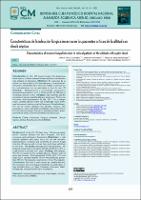| dc.contributor.author | Tinoco Solórzano, Amilcar | |
| dc.contributor.author | Ortiz Ruiz, Guillermo | |
| dc.contributor.author | Montelongo, Felipe de Jesús | |
| dc.contributor.author | Granda Luna, Ignacio | |
| dc.contributor.author | Quispe Cornejo, Armin | |
| dc.contributor.author | Quispe Montero, Maricela | |
| dc.date.accessioned | 2023-05-29T16:08:18Z | |
| dc.date.available | 2023-05-29T16:08:18Z | |
| dc.date.issued | 2023-02-14 | |
| dc.identifier.citation | Revista del Cuerpo Médico Hospital Nacional Almanzor Aguinaga Asenjo. 2022:15(4). | es_PE |
| dc.identifier.issn | 2227-4731 | |
| dc.identifier.uri | https://hdl.handle.net/20.500.12959/3734 | |
| dc.description.abstract | Introducción: En UCI, 19% tienen hongos, 23% desarrollan shock séptico. Cándida albicans el más frecuente. Antimicótico más utilizado es fluconazol. Objetivos: En residentes de la altitud con shock séptico (SS) describiremos: Características, evolución y sensibilidad de la infección fúngica invasiva (IFI) y los contrastaremos con los publicados a nivel del mar. El estudio: Retrospectivo y transversal. Analizamos hemocultivos de adultos con SS y IFIs en una UCI a 3,250 metros de altitud, durante 7 años. Hallazgos: 123 muestras. Las IFIs aumentaron 3.6 para candida albicans. Mujeres con 74 años fue frecuente. BGN representaron 52.88%, BGP 37.9% y hongos 9.22%. Cándida albicans 79.67% con sensibilidad mayor al 90% para Voriconazol, Anfotericina B y Fluconazol. Conclusiones: IFIs con SS fueron causadas por cándida albicans, IFIs aumentaron, existe adecuada sensibilidad a los antimicóticos En la altitud existe mayor frecuencia del sexo femenino, mayor promedio de edad y una buena sensibilidad al fluconazol. | es_PE |
| dc.description.abstract | Background: In the ICU, 19% have fungi, 23% develop septic
shock. Candida albicans the most frequent. The most
commonly used antifungal is fluconazole. Objectives: In high
altitude residents with septic shock (SS) we will describe:
Characteristics, evolution and sensitivity of invasive fungal
infection (IFI) and we will contrast them with those published
at sea level. The study: Retrospective and transversal. We
analyzed blood cultures of adults with SS and IFIs in an ICU at
3,250 meters of altitude, for 7 years. Findings: 123 samples.
The IFIs increased 3.6 for candida albicans. Women with 74
years was frequent. BGN represented 52.88%, BGP 37.9% and
fungi 9.22%. Candida albicans 79.67% with sensitivity greater
than 90% for Voriconazole, Amphotericin B and Fluconazole.
Conclusions: IFIs with SS were caused by candida albicans,
IFIs increased, there is adequate sensitivity to antifungals. At
high altitudes there is a higher frequency of females, higher
average age, and good sensitivity to fluconazole. | es_PE |
| dc.format | application/pdf | es_PE |
| dc.language.iso | spa | es_PE |
| dc.publisher | Seguro Social de Salud (EsSalud) | es_PE |
| dc.relation.uri | http://cmhnaaa.org.pe/ojs/index.php/rcmhnaaa/article/view/1697 | es_PE |
| dc.rights | info:eu-repo/semantics/openAccess | es_PE |
| dc.rights.uri | https://creativecommons.org/licenses/by-nc-sa/4.0/ | es_PE |
| dc.subject | Infecciones fúngicas invasoras | es_PE |
| dc.subject | Choque séptico | es_PE |
| dc.subject | Altitud | es_PE |
| dc.subject | Perú | es_PE |
| dc.subject | Invasive fungal infections | es_PE |
| dc.subject | Shock septic | es_PE |
| dc.subject | Altitude | es_PE |
| dc.title | Características de la infección fúngica invasiva en los pacientes críticos de la altitud con shock séptico | es_PE |
| dc.title.alternative | Characteristics of invasive fungal infection in critical patients of the altitude with septic shock | es_PE |
| dc.type | info:eu-repo/semantics/article | es_PE |
| dc.subject.ocde | https://purl.org/pe-repo/ocde/ford#3.02.04 | es_PE |
| dc.identifier.doi | https://doi.org/10.35434/rcmhnaaa.2022.154.1697 | |






